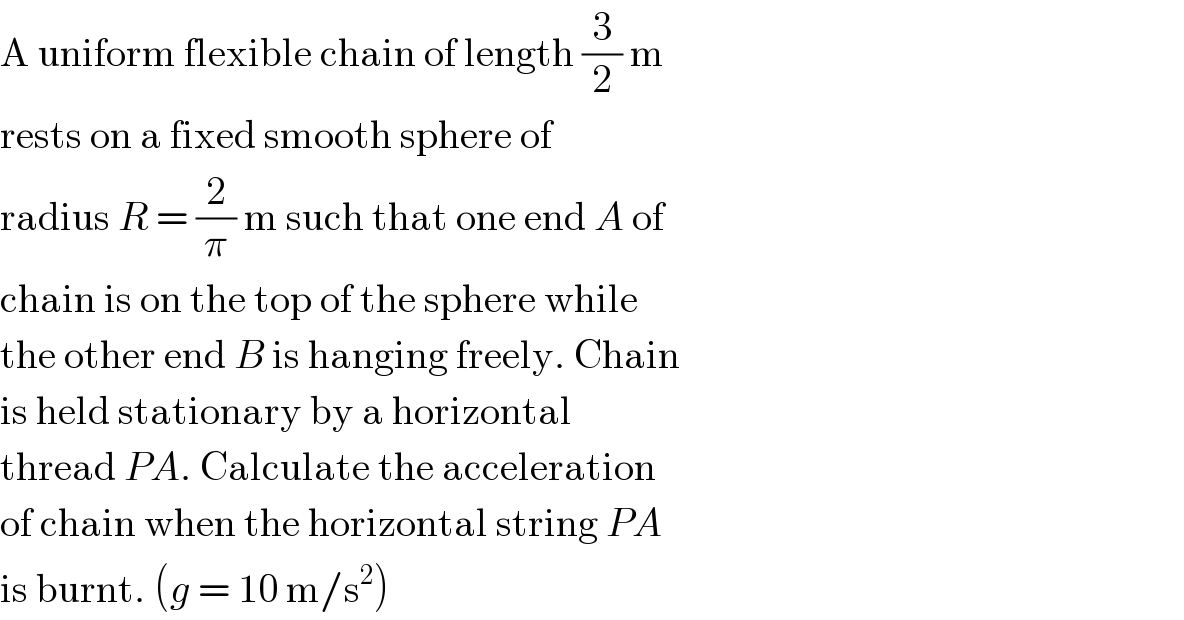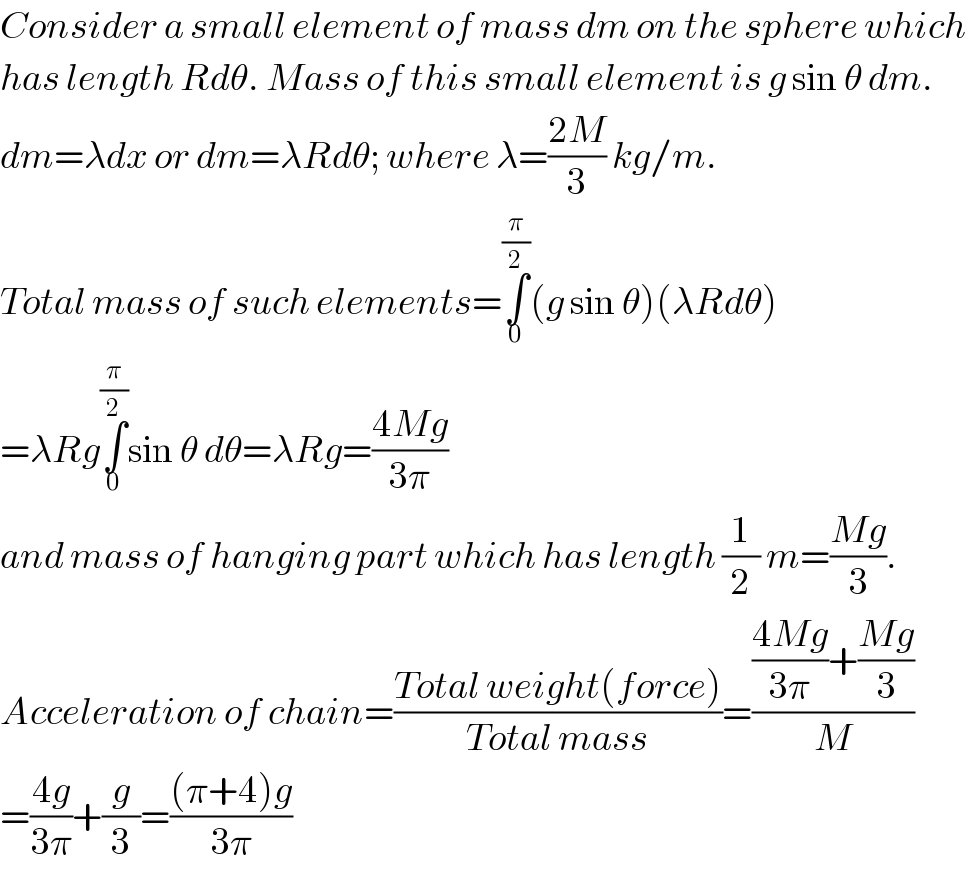
Question Number 22370 by Tinkutara last updated on 16/Oct/17

$$\mathrm{A}\:\mathrm{uniform}\:\mathrm{flexible}\:\mathrm{chain}\:\mathrm{of}\:\mathrm{length}\:\frac{\mathrm{3}}{\mathrm{2}}\:\mathrm{m} \\ $$$$\mathrm{rests}\:\mathrm{on}\:\mathrm{a}\:\mathrm{fixed}\:\mathrm{smooth}\:\mathrm{sphere}\:\mathrm{of} \\ $$$$\mathrm{radius}\:{R}\:=\:\frac{\mathrm{2}}{\pi}\:\mathrm{m}\:\mathrm{such}\:\mathrm{that}\:\mathrm{one}\:\mathrm{end}\:{A}\:\mathrm{of} \\ $$$$\mathrm{chain}\:\mathrm{is}\:\mathrm{on}\:\mathrm{the}\:\mathrm{top}\:\mathrm{of}\:\mathrm{the}\:\mathrm{sphere}\:\mathrm{while} \\ $$$$\mathrm{the}\:\mathrm{other}\:\mathrm{end}\:{B}\:\mathrm{is}\:\mathrm{hanging}\:\mathrm{freely}.\:\mathrm{Chain} \\ $$$$\mathrm{is}\:\mathrm{held}\:\mathrm{stationary}\:\mathrm{by}\:\mathrm{a}\:\mathrm{horizontal} \\ $$$$\mathrm{thread}\:{PA}.\:\mathrm{Calculate}\:\mathrm{the}\:\mathrm{acceleration} \\ $$$$\mathrm{of}\:\mathrm{chain}\:\mathrm{when}\:\mathrm{the}\:\mathrm{horizontal}\:\mathrm{string}\:{PA} \\ $$$$\mathrm{is}\:\mathrm{burnt}.\:\left({g}\:=\:\mathrm{10}\:\mathrm{m}/\mathrm{s}^{\mathrm{2}} \right) \\ $$
Commented by mrW1 last updated on 17/Oct/17
![AC^(⌢) =((πr)/2)=(π/2)×(2/π)= 1 m BC=(3/2)−1=(1/2) m ρ=mass each meter a=acceleration T_0 =tension at point C, at θ=0 (1/2)ρg−T_0 =(1/2)ρa ⇒T_0 =(1/2)ρ(g−a) −dT+ρgdscos θ=aρds −dT=ρds(a−gcos θ) −dT=ρr(a−gcos θ)dθ −∫_T_0 ^( 0) dT=ρr∫_0 ^(π/2) (a−gcos θ)dθ T_0 =ρr[aθ−gsin θ]_0 ^(π/2) T_0 =ρr[((aπ)/2)−g] (1/2)ρ(g−a)=ρ(2/π)(((aπ)/2)−g) (g−a)=(4/π)(((aπ)/2)−g) g−a=2a−(4/π)g ⇒a=((4+π)/(3π))g ≈ 7.58 m/s^2](Q22383.png)
$$\overset{\frown} {\mathrm{AC}}=\frac{\pi\mathrm{r}}{\mathrm{2}}=\frac{\pi}{\mathrm{2}}×\frac{\mathrm{2}}{\pi}=\:\mathrm{1}\:\mathrm{m} \\ $$$$\mathrm{BC}=\frac{\mathrm{3}}{\mathrm{2}}−\mathrm{1}=\frac{\mathrm{1}}{\mathrm{2}}\:\mathrm{m} \\ $$$$\rho=\mathrm{mass}\:\mathrm{each}\:\mathrm{meter} \\ $$$$\mathrm{a}=\mathrm{acceleration} \\ $$$$\mathrm{T}_{\mathrm{0}} =\mathrm{tension}\:\mathrm{at}\:\mathrm{point}\:\mathrm{C},\:\mathrm{at}\:\theta=\mathrm{0} \\ $$$$\frac{\mathrm{1}}{\mathrm{2}}\rho\mathrm{g}−\mathrm{T}_{\mathrm{0}} =\frac{\mathrm{1}}{\mathrm{2}}\rho\mathrm{a} \\ $$$$\Rightarrow\mathrm{T}_{\mathrm{0}} =\frac{\mathrm{1}}{\mathrm{2}}\rho\left(\mathrm{g}−\mathrm{a}\right) \\ $$$$ \\ $$$$−\mathrm{dT}+\rho\mathrm{gdscos}\:\theta=\mathrm{a}\rho\mathrm{ds} \\ $$$$−\mathrm{dT}=\rho\mathrm{ds}\left(\mathrm{a}−\mathrm{gcos}\:\theta\right) \\ $$$$−\mathrm{dT}=\rho\mathrm{r}\left(\mathrm{a}−\mathrm{gcos}\:\theta\right)\mathrm{d}\theta \\ $$$$−\int_{\mathrm{T}_{\mathrm{0}} } ^{\:\mathrm{0}} \mathrm{dT}=\rho\mathrm{r}\int_{\mathrm{0}} ^{\frac{\pi}{\mathrm{2}}} \left(\mathrm{a}−\mathrm{gcos}\:\theta\right)\mathrm{d}\theta \\ $$$$\mathrm{T}_{\mathrm{0}} =\rho\mathrm{r}\left[\mathrm{a}\theta−\mathrm{gsin}\:\theta\right]_{\mathrm{0}} ^{\frac{\pi}{\mathrm{2}}} \\ $$$$\mathrm{T}_{\mathrm{0}} =\rho\mathrm{r}\left[\frac{\mathrm{a}\pi}{\mathrm{2}}−\mathrm{g}\right] \\ $$$$\frac{\mathrm{1}}{\mathrm{2}}\rho\left(\mathrm{g}−\mathrm{a}\right)=\rho\frac{\mathrm{2}}{\pi}\left(\frac{\mathrm{a}\pi}{\mathrm{2}}−\mathrm{g}\right) \\ $$$$\left(\mathrm{g}−\mathrm{a}\right)=\frac{\mathrm{4}}{\pi}\left(\frac{\mathrm{a}\pi}{\mathrm{2}}−\mathrm{g}\right) \\ $$$$\mathrm{g}−\mathrm{a}=\mathrm{2a}−\frac{\mathrm{4}}{\pi}\mathrm{g} \\ $$$$\Rightarrow\mathrm{a}=\frac{\mathrm{4}+\pi}{\mathrm{3}\pi}\mathrm{g}\:\approx\:\mathrm{7}.\mathrm{58}\:\mathrm{m}/\mathrm{s}^{\mathrm{2}} \\ $$
Commented by Tinkutara last updated on 16/Oct/17

Commented by Tinkutara last updated on 17/Oct/17

$$\mathrm{Thank}\:\mathrm{you}\:\mathrm{very}\:\mathrm{much}\:\mathrm{Sir}! \\ $$
Answered by revenge last updated on 18/Oct/17

Commented by revenge last updated on 18/Oct/17

$${Consider}\:{a}\:{small}\:{element}\:{of}\:{mass}\:{dm}\:{on}\:{the}\:{sphere}\:{which} \\ $$$${has}\:{length}\:{Rd}\theta.\:{Mass}\:{of}\:{this}\:{small}\:{element}\:{is}\:{g}\:\mathrm{sin}\:\theta\:{dm}. \\ $$$${dm}=\lambda{dx}\:{or}\:{dm}=\lambda{Rd}\theta;\:{where}\:\lambda=\frac{\mathrm{2}{M}}{\mathrm{3}}\:{kg}/{m}. \\ $$$${Total}\:{mass}\:{of}\:{such}\:{elements}=\underset{\mathrm{0}} {\overset{\frac{\pi}{\mathrm{2}}} {\int}}\left({g}\:\mathrm{sin}\:\theta\right)\left(\lambda{Rd}\theta\right) \\ $$$$=\lambda{Rg}\underset{\mathrm{0}} {\overset{\frac{\pi}{\mathrm{2}}} {\int}}\mathrm{sin}\:\theta\:{d}\theta=\lambda{Rg}=\frac{\mathrm{4}{Mg}}{\mathrm{3}\pi} \\ $$$${and}\:{mass}\:{of}\:{hanging}\:{part}\:{which}\:{has}\:{length}\:\frac{\mathrm{1}}{\mathrm{2}}\:{m}=\frac{{Mg}}{\mathrm{3}}. \\ $$$${Acceleration}\:{of}\:{chain}=\frac{{Total}\:{weight}\left({force}\right)}{{Total}\:{mass}}=\frac{\frac{\mathrm{4}{Mg}}{\mathrm{3}\pi}+\frac{{Mg}}{\mathrm{3}}}{{M}} \\ $$$$=\frac{\mathrm{4}{g}}{\mathrm{3}\pi}+\frac{{g}}{\mathrm{3}}=\frac{\left(\pi+\mathrm{4}\right){g}}{\mathrm{3}\pi} \\ $$
Commented by Tinkutara last updated on 18/Oct/17

$$\mathrm{Thank}\:\mathrm{you}\:\mathrm{very}\:\mathrm{much}\:\mathrm{Sir}! \\ $$
